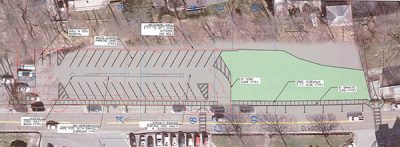Hawthorne’s Elwood Ave. Property Set for Makeover with Mt. Pleasant IDA
News Based on facts, either observed and verified directly by the reporter, or reported and verified from knowledgeable sources.

By Mike Gold
A long-vacant property on Elwood Avenue in Hawthorne is set for redevelopment, part of a broader effort by the Mt. Pleasant Industrial Development Agency (IDA) to encourage investment in the area.
The former Bel Paese restaurant, located at 408 Elwood Avenue, had been closed for more than a decade before the town of Mt. Pleasant took ownership through foreclosure. Now, the IDA has purchased the property from the town at market value and plans to convert it into a 30-space parking lot with additional green space.
The Examiner sat down with Mt. Pleasant Supervisor Carl Fulgenzi in his office last Thursday to discuss the role of the IDA. He also serves as the agency’s chairman.

Fulgenzi says the improvements aim to revitalize a long-ignored area.
“There was no real investment in that area in over 50 years,” Fulgenzi emphasized.
Alongside this project, Fulgenzi noted how the town is making several infrastructure upgrades to Elwood Avenue, also known as Route 141.
Those improvements include new sidewalks, a roundabout to improve traffic flow and pedestrian safety, historic-style street lights with hanging plants and banners, as well as new trees and landscaping.
The work is funded by a mix of town money, IDA funds, and a $1.5 million New York State grant.
Role of IDA
The Mt. Pleasant IDA offers tax incentives to developers who invest in the town, with the goal of promoting economic growth and job creation. Under its programs, companies may qualify for sales tax and mortgage tax exemptions during construction, provided they meet employment requirements.
Supporters say these incentives have helped retain businesses and encourage investment. When PepsiCo considered moving its Valhalla office to Texas, the IDA arranged a 15-year PILOT (Payment in Lieu of Taxes) agreement to keep the company in town. Similar agreements have helped companies like Regeneron expand locally, Fulgenzi also stressed.
Other projects that have received IDA support include an Amazon warehouse on Route 9A, new rental apartments at 70 Memorial Plaza in Pleasantville, medical offices at Phelps Hospital in Sleepy Hollow, and a senior assisted living facility on Grasslands Road.
Lessons from the General Motors Closure
When General Motors (GM) announced its intention to close its Sleepy Hollow (then North Tarrytown) minivan assembly plant (which meant the village would lose a huge chunk of tax monies paid by the company) government officials at the time – Governor Mario Cuomo, as well as Mt. Pleasant Town Supervisor Michael Rovello and Sleepy Hollow Mayor Phil Zegarelli – tried to retain the plant.
They deployed Mt. Pleasant IDA’s services to help accomplish that. New York State had created the IDA concept in the late 1960s.
Fulgenzi had been elected to the Mt. Pleasant town board and the IDA in 1989.
“GM closed the plant prematurely,” Fulgenzi said. The company left in 1996.
“That hurt North Tarrytown (Sleepy Hollow), in terms of property taxes,” the IDA chair and supervisor also pointed out.
The GM property is now being developed by Toll Brothers and Hines, aided by certain sales tax and mortgage exemptions from the Mt. Pleasant IDA. The 70-acre site, near the shoreline of the Hudson River, will consist of almost 1,200 condominium and townhouse units, with 135,000 square feet allocated for retail and 35,000 square feet of office space.
“There is no PILOT agreement for property taxes (at the GM site). The village receives all village taxes as assessed,” Fulgenzi wrote in an email after his sit-down interview with The Examiner.
Future Development and Challenges
Fulgenzi has expressed interest in seeing more redevelopment along Elwood Avenue and Commerce Street, with the hope that property owners will invest in upgrades if the town improves public infrastructure. The IDA is prepared to offer tax incentives to encourage private investment.
While some residents worry about traffic, infrastructure strain, and maintaining open space, Fulgenzi calls the IDA’s approach “controlled development.”
“It’s a touchy thing with development. We all would prefer woods and greenspace,” he said.
If theoretically a developer wants to build 1,500 units, for example, “that’s way too many. We negotiate (down),” Fulgenzi explained.
“Investing in Mt. Pleasant helps add to controlling school and property taxes. Smart development helps offset the inevitable annual cost increases the town must absorb,” he wrote in an email.
The Toll Brothers plan to build 162 townhomes on the 165-acre Legionaries property on Columbus Avenue in Thornwood is an example of controlled development, Fulgenzi said, noting how “lots of green space was required to be preserved” with a requirement that the project restrict residents to be 55 and older, “to control impact on the schools.”
The Legionaries will sell 49 acres of the property to New York State’s Department of Environmental Conservation (DEC) for land and watershed preservation. Another 18 acres is going to Mt. Pleasant for future recreation projects.
Fulgenzi said that he would like to see more residential development near Metro-North stations, “so people can walk to or from their apartment to the train.”
Also, he explained in an email that possibly building new rental units would “assist with our local work force and young families to be able to stay in town.”
“The challenge with building more affordable units,” he concluded, “is it requires outside funding from state and federal entities, that usually come with strings attached, but we are not giving up on finding ways to make it happen.”

Examiner Media – Keeping you informed with professionally-reported local news, features, and sports coverage.
